The Desarmillaria caespitosa (formerly known as Armillaria tabescens), common name the ringless honey fungus, belongs to the most significant division of mushrooms in the Armillaria genus. This wild mushroom may not taste like honey but sports a pleasant, honey-like golden hue. Ringless honey mushrooms are considered edible.
This species of fungus also belongs to the Armillaria genus. The Armillaria species are destructive in infecting various woody plants, including multiple species of trees.
The ringless honey mushroom grows at temperatures around 60 to 80 °F (15 to 27 degrees °C).
Its bloom time is September, when it’s the first to fruit, compared to the Armillaria mellea and Armillaria gallica.
What Are You Foraging For Right Now?
We're thrilled to hear your ideas. What would you like to submit today? Feel free to share your thoughts and experiences with us.
Between September and November, you’ll find it in the ringless honey mushroom growing in large clusters on wood.
How Do You Identify the Ringless Honey Mushroom?
Because the ringless honey mushroom has so many poisonous false lookalikes, foragers need to know how to identify this honey-colored wild mushroom.
Watch out for these distinguishing features:
Cap:
- Look at the cap’s shape, which is typically convex to flat. The color can vary but is often tan to brown. Note any scales or texture on the cap’s surface.
Gills:
- Examine the gills, which are closely spaced and attached to the stem. In the case of ringless honey mushrooms, the gills are typically white to pale cream in color.
Stem:
- Check the stem, which is usually equal in width, smooth, and lacks a ring (annulus). The base of the stem may be slightly enlarged.
White Spore Print:
- Obtain a spore print by placing the cap, gills down, on a piece of paper. The spore print of ringless honey mushrooms is whitish.
Habitat:
- Consider the habitat. Ringless honey mushrooms are often found in clusters on the wood of hardwood trees, especially oaks. They have a saprobic lifestyle, decomposing dead or decaying organic matter.
Smell:
- Descriptions of the smell can vary but may include hints of honey or mealy.
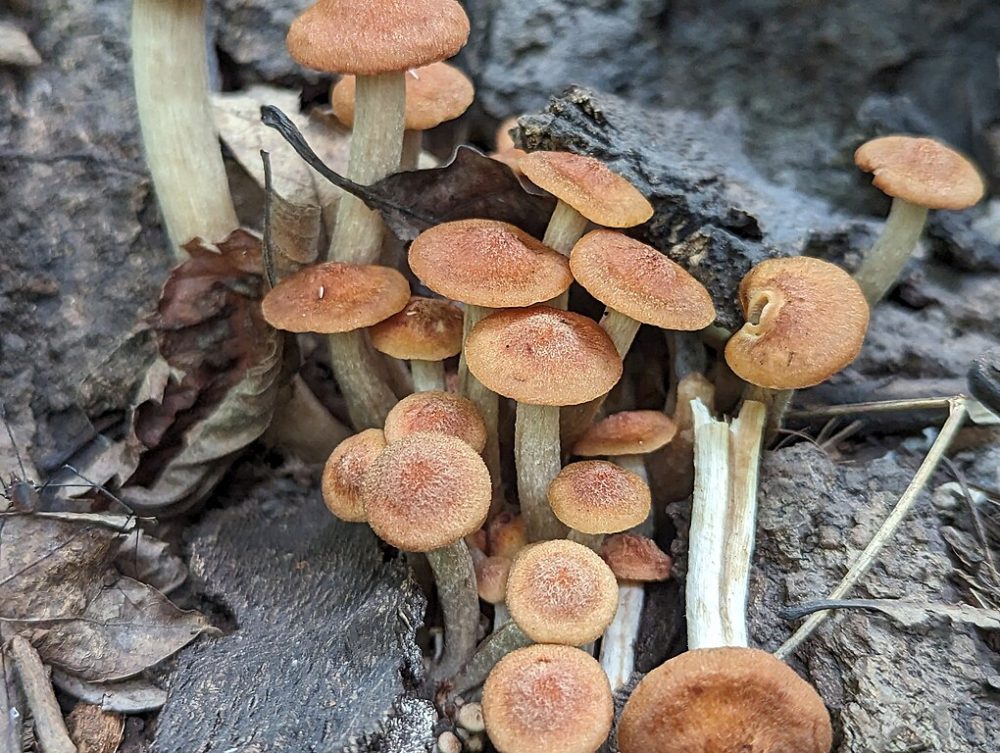


Where Does the Ringless Honey Mushroom Grow?
It grows in eastern North America, from the Great Lakes southward and west to Oklahoma and Texas.
Look for ringless honey mushrooms around the bases of trees (especially hardwood), especially where stumps or the underground roots of dead trees.
They have a preference for hardwoods with oaks. Other hardwoods like maples and hickories may also support their growth.
These mushrooms grow in clusters or groups, emerging from the wood near each other.
Is the Ringless Honey Mushroom Edible?
Ringless honey mushrooms are edible.
You should consume only firm caps and get rid of tough stalks (which you typically use for stock when cooking edible mushrooms).
Beginner foragers should pick ringless honey mushrooms growing on wood, like tree trunks or stumps.
If you don’t cook the good bits or cook it right, it has been reported to cause upset stomachs.
What Does It Taste Like?
The taste of ringless honey mushrooms is mild and somewhat nutty. They have a tender texture and absorb the flavors of the dishes they are prepared in.
How to Cook with Ringless Honey Mushrooms?
Ringless honey mushrooms can be a delightful addition to various dishes, and their mild, nutty flavor makes them versatile in the kitchen:
- Sautéing:
- Heat a bit of oil or butter in a pan, add sliced ringless honey mushrooms, and sauté until they are golden brownish. This method enhances their natural flavors.
- Stir-Frying:
- Include ringless honey mushrooms in stir-fries for added texture and flavor. Cook them with other vegetables, proteins, and your favorite stir-fry sauce.
- Grilling or Roasting:
- Larger, firmer mushrooms can be grilled or roasted. Toss them with olive oil, garlic, herbs, and seasonings before grilling or roasting until they are tender and slightly caramelized.
- In Pasta Dishes:
- Add sautéed ringless honey mushrooms to pasta dishes. They pair well with various pasta shapes and can complement creamy or tomato-based sauces.
- In Soups and Stews:
- Enhance the flavor of soups and stews by adding sliced or chopped ringless honey mushrooms. They can absorb the broth’s flavors and contribute their own unique taste.
- Pizza Topping:
- Use sautéed ringless honey mushrooms as a pizza topping. They can add a savory and earthy element to your pizza creations.
- Omelets or Quiches:
- Incorporate ringless honey mushrooms into omelets, frittatas, or quiches for a delightful breakfast or brunch option.
- Pickling:
- Explore pickling ringless honey mushrooms for a different flavor profile. Pickled mushrooms can be a tasty addition to salads, sandwiches, or charcuterie boards.
Does the Ringless Honey Mushroom Have Any Lookalikes?
Even mushroom experts can be fooled by the many ringless honey mushroom lookalikes. Some examples include:
- Honey Agaric (Armillaria mellea): EDIBLE
- The true honey mushroom (A. mellea) can look similar to ringless honey mushrooms, especially when young. However, true honey mushrooms have a partial veil that leaves a ring on the stem, distinguishing them from the ringless honey mushrooms.
- Deadly Galerina (Galerina marginata): POISONOUS
- The deadly galerina is a poisonous mushroom that can resemble ringless honey mushrooms. It is smaller and lacks the ringless stem. Proper identification is crucial to avoid toxic ingestion.
- Sulfur Tuft (Hypholoma fasciculare): POISONOUS
- Sulfur tuft mushrooms share a similar clustered growth pattern with ringless honey mushrooms. However, sulfur tufts have a different cap color (bright yellow to orange) and typically grow on wood or woody debris.
- Armillaria sinapina: EDIBLE
- This species is closely related to ringless honey mushrooms and can look very similar. It may have a ring on the stem.
- Amanita Species: POISONOUS
- Some Amanita species, like the destroying angel (Amanita bisporigera) or death cap (Amanita phalloides), may share some visual similarities but can be deadly toxic. Amanitas usually have a volva (cup-like structure at the base) and other distinguishing features.
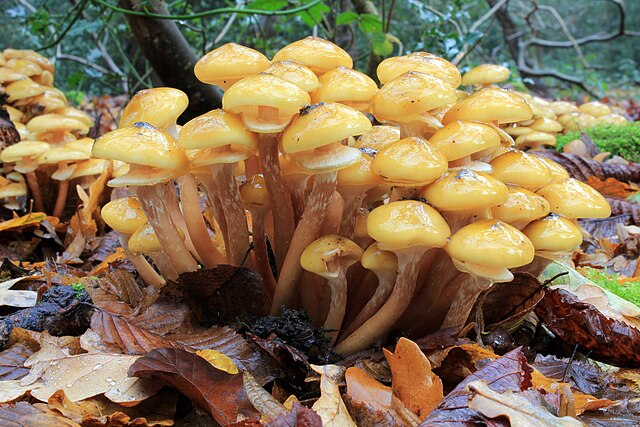
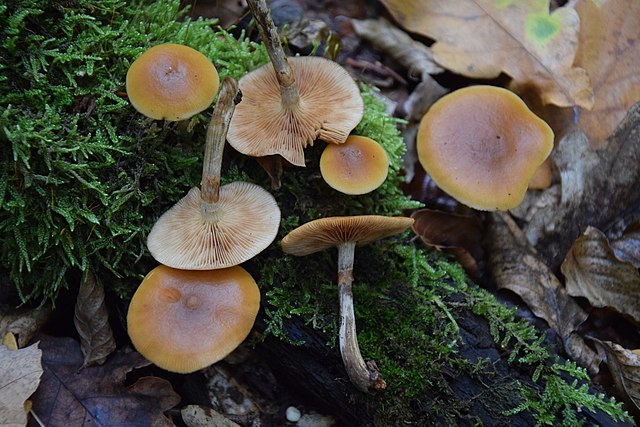
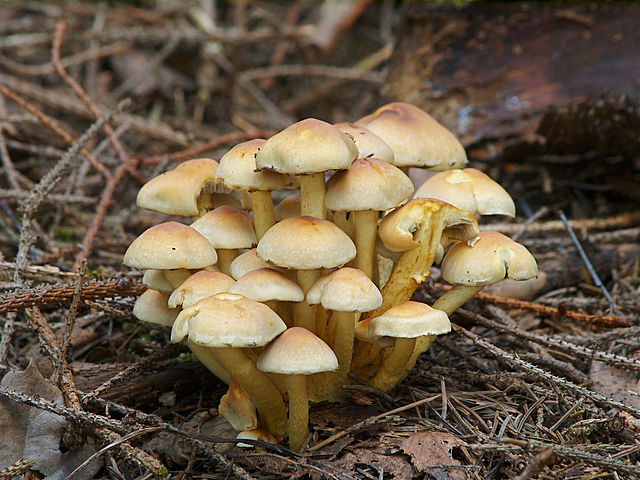
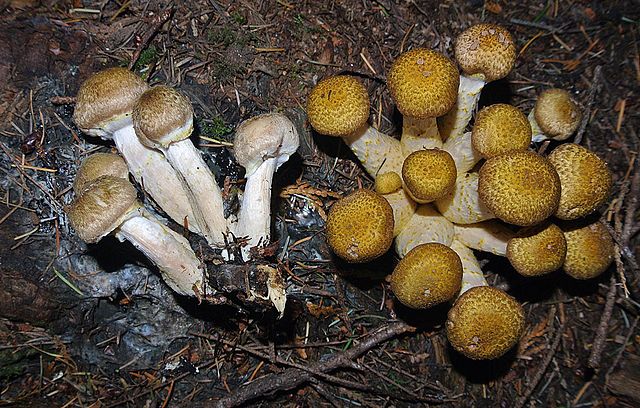
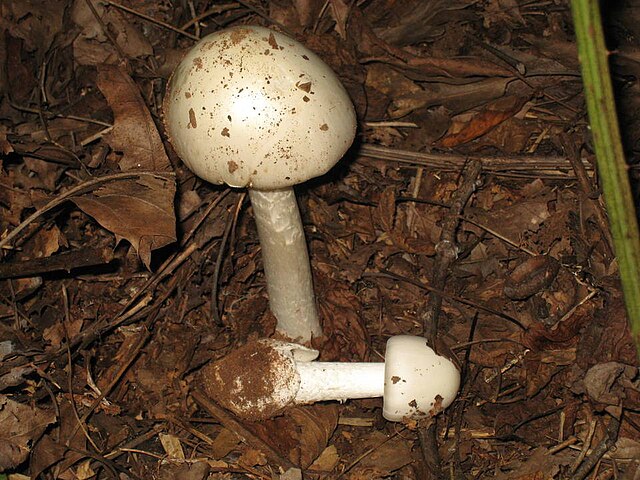
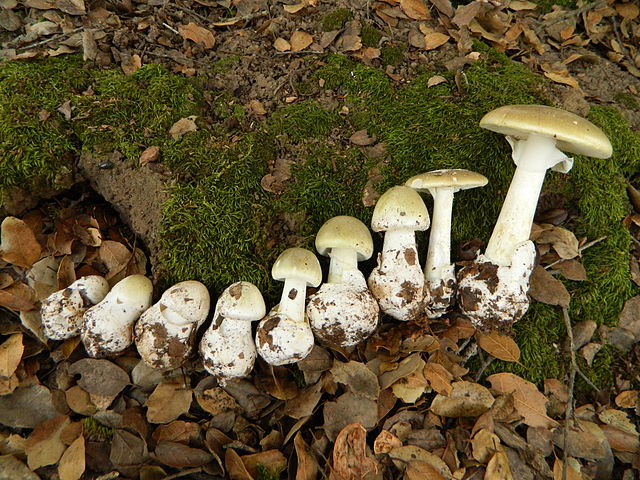
When to Forage for Ringless Honey Mushrooms?
Ringless honey mushrooms are often most abundant in late summer and fall. Fruiting is favored by cooler temperatures. As the weather begins to cool in late summer and early fall, these mushrooms may appear.
Periods of rain or consistent humidity encourages their fruiting.
Regularly check the areas where you’ve previously found ringless honey mushrooms, as they can appear in the same locations in subsequent years.
Getting into the great, wet outdoors in search of edible plants, herbs, fruits and fungi is one of Sarah’s favorite outdoor pursuits. She thinks there’s nothing better than combining her passion for hiking with the start of the foraging season. Sarah’s definitely not afraid of a little rain and dirt, it’s all part of the fun.

